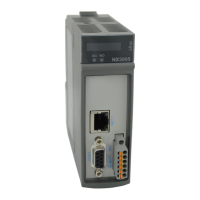6. REDUNDANCY WITH NX3030 CPU
Redundant CPU General Features
Commands that drive the
CPU out of the reserve state
- Commands via redundancy control panel (PX2612).
- Commands received from MasterTool or from a SCADA
system, through this CPU (local) or the other CPU (remote).
- Commands generated by user application (e.g.: in case
of other diagnostics as Ethernet communication failure)
through this CPU (local) or the other CPU (remote).
Switchover time
- Up to 3 cycles from the MainTask, depending on the stim-
ulus for state change (command or failure).
- In case of PROFIBUS network failure, 2 MainTask cycles
+ 500 ms.
No discontinuities switchover
(bump-less)
- A switchover doesn’t cause discontinuities in the controller
outputs, nor in the inner variables.
Redundancy overhead (Main-
Task cycle CPU consuming in-
creased by redundancy)
- Maximum value automatically calculated by MasterTool
and informed to the user, considering an empty redundant
forcing list.
- Typical average value of 60 ms for 224 kbytes of redundant
data, in a system with a redundant PROFIBUS network and
two redundant Ethernet HSDN networks
CPU display
Among other diagnostics, shows the redundancy state (Ac-
tive, Stand-by, Inactive, Not-configured and Starting) to-
gether with the CPU identification PLCA or PLCB.
Redundancy Control Panel
PX2612
- Through buttons, allows commands of switchover or re-
dundancy states transition for maintenance.
- LEDs signalize the redundancy state in each half-cluster.
- NO relay allows a half-cluster to switch off the other in
extreme situations. A button allows the other half-cluster
reactivating.
- Embedded resources for buttons, LEDs and relays tests.
- A project created with panel cannot be converted to a
project without panel, and vice-versa.
Redundancy diagnostics
- Indicate failures in the PLCA and in the PLCB, indepen-
dent of their states (Active or Inactive).
- Prevent “obscure failures”.
- Allow quick maintenance, essential for high availability.
Redundancy commands
- Allow the execution of the same PX2612 control panel ac-
tions, among other commands (e.g. switchover command).
- Can be executed in the local CPU, or transmitted to
the other CPU (remote) via synchronism channels NE-
TA/NETB.
- Can be received through MasterTool or a SCADA system.
- Can be executed through user application.
Redundancy events
Register diagnostics and redundancy commands changes,
with timestamp, allowing an investigation of the switchover
causes.
SNTP (Simple Network Time
Protocol)
Allow the events to have a precise timestamp adjusted to the
world hour. It also synchronizes the CPU real time clock for
other applications.
Commands and diagnostics
synchronization
Each MainTask cycle, PLCA and PLCB exchange diagnos-
tics and commands through synchronism channels NETA or
NETB. This way, a CPU knows the other diagnostics and
commands.
276

